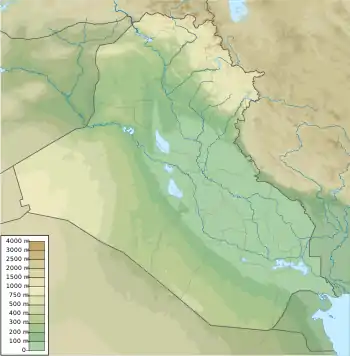Lake Hamrin
Lake Hamrin, is a man-made lake approximately 50 km north-east of the Baqubah, in Iraq's Diyala Governorate. The town of Hamrin sits on the western shore of the lake, both of which are at the southern tip of the Hamrin mountains.
| Lake Hamrin | |
|---|---|
 Lake Hamrin | |
| Location | Diyala Governorate |
| Coordinates | 34°11′28″N 44°59′42″E |
| Type | reservoir |
| Basin countries | Iraq |
| Surface area | 340 km2 (130 sq mi) |
| Water volume | 2×109 m3 (1.6×106 acre⋅ft) |
| Settlements | Hamrin |
It was established in 1981 as an artificial dam to hold over two billion cubic metres of water. It is a source of fish and also provides water for nearby date palm orchards and other farms.
In June 2008, it was reported that due to Iranian damming of the Alwand River, the lake had lost nearly 80% of its capacity.[1]
Archaeological excavations
In the late 1970s, prior to the flooding of the lake, several archaeological sites in the flood plain were excavated. Excavations were led by the British Archaeological Expedition at the request of the Iraqi State Organisation for Antiquities and Heritage. Sites excavated include the Ubaid period sites of Tell Madhur, Tell Rubeidheh and Tell Haizalun.[2] The Hamrin sites probably shared a localised form of the Ubaid culture and possibly operated as one administrative unit based out of Tell Abada.[3]
References
- http://www.irinnews.org/report.aspx?ReportID=78802
- Roaf, M. 1982. "The Hamrin Sites." In: J. Curtis (ed.) Fifty Years of Mesopotamian Discovery. London: The British School of Archaeology in Iraq. pp 40–47
- Jasim, S. 1985. "The Ubaid period in Iraq. Recent excavations in the Hamrin region." British Archaeological Reports International Series: 267
